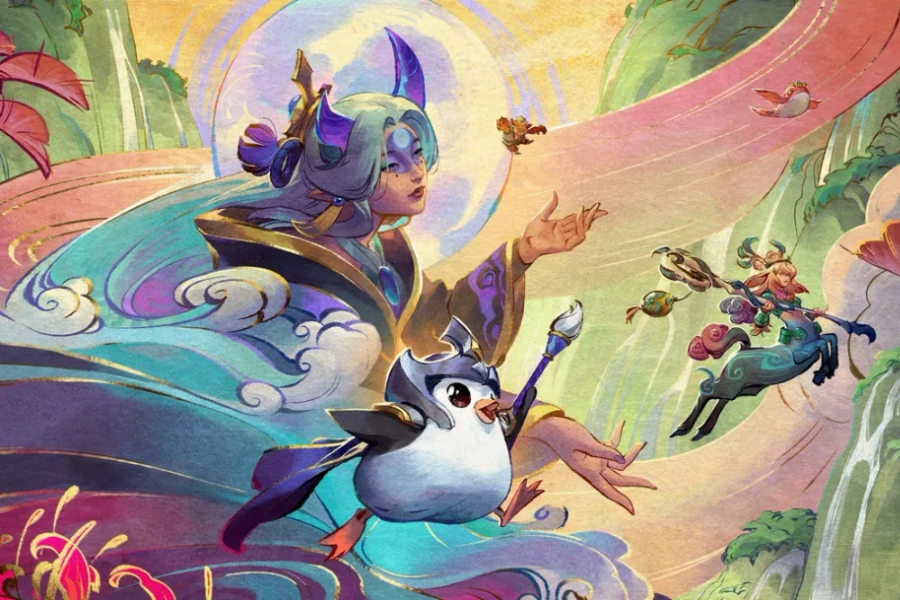Introduction
Teamfight Tactics (TFT) is an auto-battler game beloved by many, where sharp strategy and quick decisions are key to securing victory. Among the diverse champions, Kindred is particularly noteworthy due to its unique mechanics and game-altering abilities. However, a debate persists within the TFT community: should you opt for Red or Blue with Kindred? In this guide, we’ll explore the details of both compositions, helping you decide which path to take in your next game.
Understanding Kindred
Kindred’s Role in TFT
Kindred is a dual-natured champion that embodies both a hunter (Lamb) and the hunted (Wolf). In TFT, Kindred typically serves as a backline damage dealer with potent utility, thanks to their ultimate ability, which can turn the tide of battle by saving allies from certain death.
Unique Abilities and Skills
Kindred’s skill set revolves around inflicting sustained damage and offering critical survival benefits to their team. Their ultimate, “Lamb’s Respite,” creates a protective zone where no unit can die, making it an essential tool in close encounters.
Strengths and Weaknesses
Strengths:
- High burst damage potential.
- A game-changing ultimate ability.
- Strong synergy with various team compositions.
Weaknesses:
- Highly reliant on proper positioning.
- Vulnerable without optimal items.
- Needs to be supported by a strong team composition to truly excel.
The Debate: Red or Blue Kindred?
Overview of the Debate
The choice between Red and Blue Kindred hinges on their distinct playstyles and the synergies they offer to your team. Red Kindred is focused on maximizing damage output through specific itemization, while Blue Kindred emphasizes utility and survivability.
Key Factors to Consider
- Team Composition: Consider which champions you have and how they synergize with Kindred.
- Items Available: The items you’ve acquired significantly influence which build is optimal.
- Game State: Assess whether your team needs more damage or additional utility to secure the win.
Community Opinions and Insights
The community remains divided, with top players and streamers often showcasing effective strategies for both variations. Some argue that Red Kindred’s raw damage output is unrivaled, while others appreciate the versatility and safety provided by Blue Kindred.
Red Kindred Composition
Overview of Red Kindred
Red Kindred builds are centered around enhancing attack speed and critical strike damage, turning Kindred into a formidable damage dealer capable of carrying the team.
Ideal Team Compositions
- Ranger/Shadow Build: Pairing with Rangers and Shadows amplifies damage output, making Kindred a key part of your backline.
- Assassin/Ranger Hybrid: Integrating Assassins adds a layer of front-to-back combat synergy, increasing overall team effectiveness.
Synergies with Other Champions
- Ashe and Vayne: Fellow Rangers who benefit from attack speed boosts, complementing Kindred’s role.
- Sion and Yorick: Shadow champions that offer stability to the frontline, protecting Kindred as they dish out damage.
Itemization for Red Kindred
- Guinsoo’s Rageblade: Crucial for stacking attack speed, enabling Kindred to unleash more attacks.
- Infinity Edge: Increases critical strike damage, making each hit more devastating.
- Rapid Firecannon: Extends attack range and boosts attack speed, keeping Kindred safe while dealing damage.
Blue Kindred Composition
Overview of Blue Kindred
Blue Kindred focuses on utility and survivability, utilizing items that enhance mana generation and defense, allowing for more frequent use of their ultimate.
Ideal Team Compositions
- Mystic/Warden Build: Combining Mystics and Wardens boosts defensive stats, creating a durable team that can withstand heavy attacks.
- Mage/Spirit Hybrid: Integrating Mages and Spirits accelerates ultimate casts, maximizing the utility of Kindred’s abilities.
Synergies with Other Champions
- Lulu and Janna: Mystics that add crowd control and healing, enhancing the team’s overall durability.
- Nautilus and Thresh: Wardens who provide a solid frontline, giving Kindred the protection needed to survive and support the team.
Itemization for Blue Kindred
- Seraph’s Embrace: Increases mana regeneration, allowing Kindred to use their ultimate more frequently.
- Guardian Angel: Grants a second chance if Kindred is focused down, adding to their survivability.
- Redemption: Heals allies in the area, further boosting team survivability during prolonged battles.
Gameplay Strategies for Red Kindred
Early Game Tactics
- Focus on Economy: Build a strong economy to ensure you can secure the necessary items for Red Kindred.
- Prioritize Rangers: Aim to collect Rangers early in the game to establish synergy and start stacking attack speed.
Mid-Game Adjustments
- Adapt to Opponents: Scout your opponents frequently and adjust your strategy based on their composition.
- Strengthen Frontline: Ensure your frontline is sturdy enough to protect Kindred while they deal damage.
Late-Game Strategies
- Optimize Positioning: Place Kindred in a position where they can maximize their damage output without being easily targeted.
- Monitor Opponents: Continually scout enemy threats and reposition Kindred accordingly to avoid being countered.
Positioning and Placement Tips
- Backline Placement: Always position Kindred in the backline to protect them from initial engagements.
- Adjust Based on Threats: Move Kindred around the board to dodge enemy assassins and other high-damage threats.
Gameplay Strategies for Blue Kindred
Early Game Tactics
- Focus on Defense: Build a solid defensive line with Wardens to protect Kindred in the early stages of the game.
- Collect Mana Items: Prioritize items that enhance mana regeneration to enable frequent use of Kindred’s ultimate.
Mid-Game Adjustments
- Boost Survivability: Incorporate Mystics to enhance the team’s defensive capabilities.
- Watch Item Drops: Adapt your itemization strategy based on the items you collect throughout the game.
Late-Game Strategies
- Strategic Ultimates: Use Kindred’s ultimate judiciously to sway the outcome of crucial battles.
- Maintain Balance: Ensure your team composition is well-rounded to support Kindred’s utility role.
Positioning and Placement Tips
- Center Positioning: Position Kindred centrally to maximize the area of effect of their ultimate.
- Support Proximity: Keep supportive champions nearby to capitalize on the protective zone created by Kindred’s ultimate.
Common Mistakes to Avoid
Pitfalls in Choosing Compositions
- Overcommitting Early: Avoid committing to a specific composition too early in the game without flexibility.
- Ignoring Synergies: Ensure that all champions in your composition complement each other’s strengths.
Misuse of Items
- Wrong Prioritization: Focus on items that best suit Kindred’s intended role in your composition.
- Item Overlap: Avoid overlapping items that don’t synergize well, potentially wasting their effects.
Poor Positioning
- Vulnerable Placement: Avoid placing Kindred in positions where they can be easily targeted and eliminated.
- Ignoring Assassins: Always account for enemy assassins and adjust Kindred’s position to mitigate their threat.
Adapting to Opponents
Scouting Techniques
- Frequent Scouting: Regularly check on your opponents to adapt your strategy accordingly.
- Identify Threats: Look for key threats that can counter your composition and adjust your approach.
Adjusting Strategies Based on Opponents
- Flexibility is Key: Be ready to pivot your strategy based on the opposition’s strengths and weaknesses.
- Countering Compositions: Understand how to counter the popular compositions you face in each game.
Meta Considerations
Current Meta Analysis
- Meta Trends: Stay informed about current meta trends to understand which compositions are dominating the game.
- Adaptation: Be prepared to adapt your Kindred build to fit within the current meta context.
How Red and Blue Kindred Fit into the Meta
- Red Kindred: Typically shines in damage-heavy metas where raw damage output is crucial.
- Blue Kindred: Excels in utility-focused metas, where survivability and crowd control are key factors.
Predicting Meta Shifts
- Stay Informed: Keep up with the latest patches and updates to anticipate potential shifts in the meta.
- Community Insights: Follow discussions within the TFT community to stay ahead of emerging trends.
Expert Tips and Tricks
Insights from Top Players
- Watch Streams: Observe top players’ streams to gain insight into their strategies and decision-making processes.
- Analyze Matches: Review high-level matches to understand how top players utilize Kindred effectively.
Advanced Tactics
- Micro-Adjustments: Make small adjustments in positioning and itemization that can significantly impact your success.
- Timing Ultimates: Master the timing of Kindred’s ultimate to ensure maximum effectiveness during critical moments.
Optimizing Performance
- Consistent Practice: Regular practice is essential to improving your decision-making and reflexes in-game.
- Community Engagement: Engage with the TFT community for tips, updates, and advice to stay competitive.
Conclusion
In “Teamfight Tactics,” the decision between Red or Blue Kindred is a pivotal one, each offering distinct advantages depending on your playstyle and the current game state. Red Kindred excels in dealing massive damage and carrying your team through relentless attack speed and critical strikes, making it ideal for offensive strategies. On the other hand, Blue Kindred focuses on utility and survivability, providing crucial support and protection to your team during key moments. Understanding your team’s needs, available items, and the game’s current meta will help you make the right choice and lead your team to victory. Whether you go Red or Blue, mastering Kindred’s positioning, itemization, and synergy with other champions will be key to your success in TFT.
FAQs
1. Which is better: Red or Blue Kindred in TFT?
The better option depends on your team composition and game strategy. Red Kindred is ideal for maximizing damage output, while Blue Kindred is better for enhancing utility and survivability.
2. What items are best for Red Kindred?
The best items for Red Kindred include Guinsoo’s Rageblade, Infinity Edge, and Rapid Firecannon, all of which boost attack speed, critical strike damage, and range.
3. What items should I prioritize for Blue Kindred?
For Blue Kindred, prioritize Seraph’s Embrace, Guardian Angel, and Redemption to increase mana regeneration, survivability, and team support.
4. How do I position Kindred in TFT?
Kindred should be placed in the backline to protect them from initial damage. For Red Kindred, ensure they are positioned safely to maximize their attack output, while Blue Kindred should be centrally placed to maximize the effectiveness of their ultimate.
5. How do I counter opponents when using Kindred?
Regularly scout your opponents to adapt your strategy. If facing heavy damage dealers, consider Blue Kindred for its utility. If the enemy has a fragile backline, Red Kindred can capitalize on that with high burst damage.
6. What are common mistakes to avoid when using Kindred?
Common mistakes include mispositioning, overcommitting to a specific build too early, ignoring champion synergies, and misusing items that don’t complement Kindred’s role.
Explore the latest news and updates on headlines



